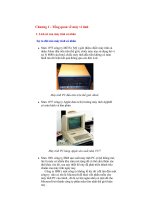TỔNG QUAN VỀ auction
Bạn đang xem bản rút gọn của tài liệu. Xem và tải ngay bản đầy đủ của tài liệu tại đây (89.41 KB, 3 trang )
Chapter 10 E-Auctions
Answers to EC Application Case Questions
EC Application Case 10.1: Procurement Via Auctions at STE
1.
Why was it necessary to restructure the purchasing process?
The firm was seeking to reduce costs, while increasing its supplier base.
2.
Why, in your opinion, was it beneficial for STE to use an intermediary? (Hint: See Chapter 5.)
The intermediary provided tools, advice and legitimacy..
3.
Explain how STE’s five goals can be achieved by using a reverse-auction process.
The system:
Minimized costs through competition
Identified new suppliers through the bid process
Increased efficiency by issuing the RFQ to one location
Found new suppliers for support during the bid process
Consolidated suppliers with one bid.
EC Application Case 10.2: Online Wine Grape Auction
1.
What drives auctions in the winery exchange?
The exchange helps establish fair prices while reducing costs.
2.
Enter winebide.com and find how auctions are conducted.
Student reports will vary.
2.
Why is the C2B model successful?
It allows for greater control, information and access to antique wines.
2.
Find other sites that auction wines and compare them with winebid.com.
Student reports will vary.
Answers to Discussion Questions
1. Discuss the advantages of dynamic pricing over fixed pricing. What are the potential disadvantages?
Benefits of dynamic pricing to sellers include:
Increased revenues by broadening customer base and shortening cycle time. With e-auctions, sellers
can reach the most interested buyers in the most efficient way and sell at a price equal to buyer
valuation of the product. This eliminates the need to predict demand and the risk of pricing items too
high or too low.
Optimal price setting. Sellers can make use of the information collected about price sensitivity to set
prices in other fixed-price markets.
Disintermediation. Sellers can gain more customer dollars by offering items directly, rather than
going through an expensive intermediary or by using an expensive physical auction.
Better customer relationships. Buyers and sellers have more chances and time to interact with each
other, thus creating a sense of community and loyalty.
Liquidation. Sellers can liquidate large quantities of obsolete items very quickly.
2. The “name-your-own-price” model is considered to be a reverse auction. However, there is no RFQ or
consecutive bidding, so why is it called an auction? Is it an auction at all?
Like reverse auctions, the “name-your-own-price” model has one buyer and many potential sellers. The
price the buyer is willing to accept works like an RFQ.
3. Find some material on why individuals like C2C auctions so much. Write a report.
There are many interesting theories. One theory suggests that online auctions are similar to gambling and
people participate in order to “win.”
4. Compare the “name-your-own-price” and RFQ approaches. Under what circumstances is each
advantageous?
The main drawback to the “name-your-own-price” model is that typically the buyer must be somewhat
flexible in the goods or services received. For example, on Priceline.com the buyer cannot choose the
airline or even the exact time of a flight. In an RFQ system, the buyer has control over the exact goods and
services required.
5. Identify three fraud practices in which a seller might engage. How can buyers protect themselves?
Seller fraud practices include: shilling, fake photos and misleading descriptions, improper grading, selling
reproductions, high shipping costs, and failure to ship. Buyers can protect themselves in the following
ways: use authentication services, use grading services, check the feedback forum, insurance policies,
escrow services, appraisal services, and verification.
6. Identify three fraud practices in which a buyer might engage. How can sellers protect themselves?
Buyer fraud practices include: bid shielding, loss and damage claims, and switch and return. Sellers can
protect themselves in the following ways: user verification, feedback forum, escrow services, and nonpayment punishment.
7. It is said that Manheim Auction is trying to sell more online without cannibalizing its core business.
Discuss this situation.
Manheim Auction needed to move online in order to counter competition in its main business, used
automobile auctions. The company needs to move carefully so it does not alienate its off-line business. The
complete Manheim Auctions case can be found at
/>8. Discuss the need for software agents in auctions. Start by analyzing proxy bidding and auction
aggregators.
In general, software agents assist participants in auctions by automating some of the key aspects of the
process. For example, agents can find products available and negotiate the price. Proxy bidding uses a
software system to place bids on behalf of the buyer. The buyer determines his or her maximum bid and
places the first bid manually. The proxy system will then increase the bid based on future bids by others
until the auction ends or the maximum bid is reached. Auction aggregators use intelligent agents to find and
track auctions on multiple auction sites. However, this practice is controversial and large auction sites, such
as eBay, will not allow agents on their site.
9. Discuss the role of auction aggregators.
These firms attempt to display all auctions for particular products offered on several auction sites. This is a
service to buyers and is usually using an advertising revenue model.
10. It is said that individuals prefer an English auction whereas corporations prefer a Dutch one. Speculate
on the reasons for this.
Student responses will vary. It may be easier for individuals to concentrate a single item whiles businesses
may want multiples.
11. When Google made its initial IPO in 2004, it used a Dutch auction. What was the logic of this?.
It allowed the company to secure the maximum available capitalization from the market while decreasing
the commissions paid to financiers.
12. Relate consumer trust to auctions.
Trust is required when making any online purchase. C2C auctions make this difficult, with trust being
invested in the auction site more than the individual buyer or seller.
Answers to End-of-Chapter Real-World Case Questions: Dynamic Trading at OceanConnect.com
1.
Why is it important to consider more than the price in auctions?.
Because the specifications (quality) and the location of the product may vary.
2.
Additional parameters, such as delivery time and location, are using negotiation techniques such
as those described in this in Chapter 6 and facilitated by the software provided by OceanConnect.com.?
How do they relate to the bidding price? Why is the software support of manual negotiation so critical?
Explain the value of the Instant Messaging to the negotiation process.
Other factors will affect the bidding price because of their relative worth to the buyer. Software support
allows for greater information transparency and organization. IM allows for clarification of auction
before closing.
3.
Comment on the complexity of a market such as this one.
This market is very complex, necessitating software that is very adaptable..
4.
Why does OceanConnect.com need several transaction models?
Several transaction models are needed due the variations in the products offered.
5.
OceanConnect.com is an exchange. Given what you learned about the successes and failures of
exchanges, identify the success factors of this exchange..
Successful exchanges generally provide appropriate tools to buyers and remain as honest brokers in
negotiation..
6.
Do you think that the negotiated parameters can be incorporated into the electronic bidding
process someday? Why or why not??
Student responses will vary.









